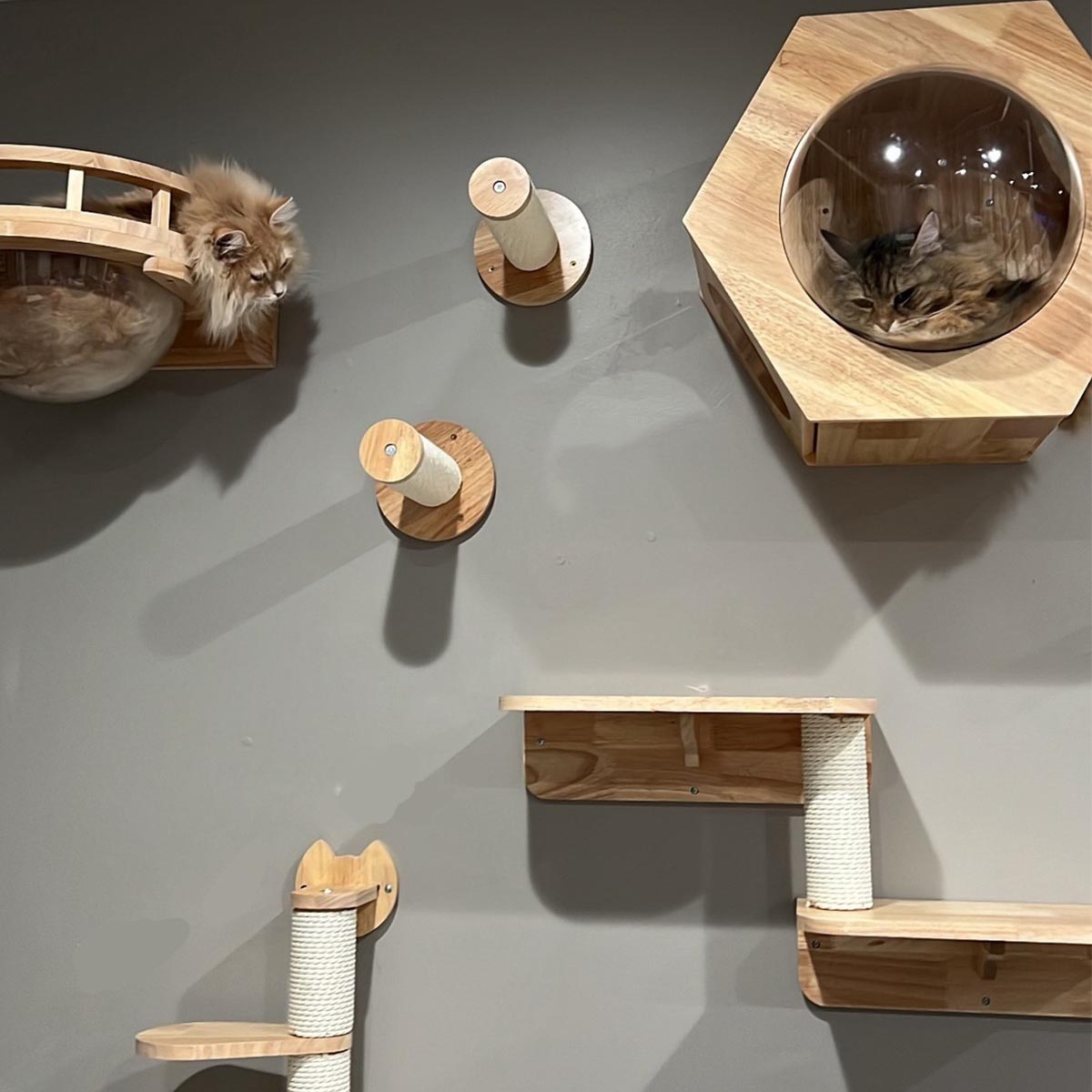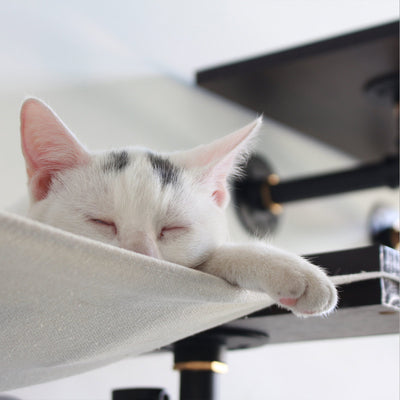Wall-mounted cat shelves represent a creative evolution in cat furniture, merging practicality with modern design. Unlike traditional floor-standing models, these cat trees are affixed directly to the wall, creating an engaging vertical environment for cats. These structures typically incorporate elements like shelves, perches, and occasionally bridges or ladders, arranged to encourage cats to leap, climb, and relax at various heights.
The appeal of wall-mounted cat trees extends to both feline inhabitants and their human counterparts for several reasons. One of the most compelling advantages is their space-saving design. For smaller living spaces, such as apartments or compact homes, where floor space is at a premium, these cat trees are particularly beneficial. They provide a play and relaxation area for cats without consuming valuable floor area.
Additionally, wall-mounted cat trees often boast a more modern and minimalist design than their floor-standing counterparts, allowing them to blend seamlessly into home decor. This stylistic approach makes them an attractive addition to a room, enhancing the aesthetic appeal of the space.
Catering to a cat’s inherent desire to climb and observe from elevated positions, these cat trees offer vertical space for such activities. This not only satisfies their natural climbing instincts but also provides mental stimulation and physical exercise, contributing to their overall well-being.
Many wall-mounted cat trees come with the option for customization. This flexibility allows cat owners to tailor the layout to suit their specific space constraints and their cat’s individual preferences, creating a personalized climbing experience.
When incorporating a wall-mounted cat tree into your home, safety is a paramount concern. It’s crucial to anchor the tree’s components firmly to wall studs, ensuring they can withstand your cat’s weight. This prevents the possibility of the units loosening or collapsing. Components should be positioned at a height that’s accessible and safe for your cat. Moreover, their placement should not disrupt household movement or create potential hazards. Consistent inspection of all mounts, shelves, and attachments is necessary to identify any signs of wear or loosening. Prompt tightening and adjustments of fixtures are essential for ongoing safety. If you’re not confident in your installation skills, seeking the help of a professional is advisable to guarantee a safe and secure setup.
In conclusion, wall-mounted cat furniture offer an innovative solution for cat owners seeking a functional, stylish, and space-efficient way for their cats to indulge in climbing and perching. However, ensuring a safe and stable installation is crucial for the enjoyment and safety of these unique cat playgrounds.
Choosing the Right Wall-Mounted Cat Shelf
Choosing the right wall-mounted cat shelf involves several important considerations to ensure it seamlessly fits into your home and meets your cat’s needs.
Begin by assessing the available space where you intend to install the cat shelves. Measure both the height and width of the area to confirm it can accommodate the tree without overcrowding. Additionally, ensure that there are clear pathways for your cat to climb on and off the shelves, and that the chosen location is easily accessible to them. Different wall types may require specific mounting hardware, so consider the construction of your walls.
To make a suitable choice, take your cat’s characteristics into account. Age plays a significant role, as kittens may prefer lower shelves, while active adult cats might enjoy taller structures. Seniors may appreciate accessible cat perches. Consider your cat’s size and select shelves and perches that provide ample space for them to stretch out and lounge comfortably. Matching the tree’s design to your cat’s activity level is crucial; active cats may benefit from more complex structures with various levels, while calmer cats might prefer simpler designs.
When evaluating wall-mounted cat shelves, prioritize material quality. Look for trees made of durable materials like solid wood or metal brackets. Avoid options with flimsy or weak materials that may not withstand long-term use. Assess the surface materials your cat will come into contact with; they should be comfortable and easy to clean. Common choices include sisal, carpet, and soft faux fur. Examine the overall design, including the layout of shelves, perches, and hideaways. Some designs feature built-in scratching posts or cubbies for cats to explore. Consider the aesthetic appeal as well, selecting a cat tree that complements your home’s decor. Various designs, from modern to rustic or minimalist, are available to match different interior styles. Additionally, some wall-mounted cat shelves offer customization options, allowing you to adjust the layout to suit your cat’s preferences and the available space.
By carefully considering your space, your cat’s characteristics, and the materials and design of wall-mounted cat trees, you can make an informed choice that not only enhances your home but also provides your feline companion with a safe and enjoyable climbing and perching experience.

Preparation for Wall-Mounted Cat Tree Installation
Preparing for the installation of a wall-mounted cat tree involves gathering the necessary tools and materials, identifying your wall type, and taking safety precautions to ensure a secure and safe installation.
First, ensure you have all the required tools and materials ready. This includes the complete wall-mounted cat tree kit, which should include shelves, brackets, screws, and any additional components. You will also need a measuring tape to accurately measure the installation area, a stud finder to locate wall studs for secure mounting, a level to ensure components are installed evenly, a pencil or marker for marking the placement of brackets and shelves on the wall, a drill to create pilot holes for screws and mount brackets, and a screwdriver for tightening screws and securing components. If you have drywall and cannot locate studs, you may need wall anchors for added stability.
Next, identify your wall type. If your wall feels soft and hollow when you knock on it, it’s likely drywall. In this case, locate wall studs for secure mounting. Running a stud finder along the wall will help you locate the vertical wooden or metal studs behind the drywall, which are ideal anchor points for your cat tree. If your wall is hard, solid, and doesn’t have visible studs, it may be made of concrete or brick. Specialized mounting hardware is required for such walls.
Safety precautions are crucial for a secure installation. Always mount the cat tree components securely to prevent them from falling and potentially injuring your cat or people. Be aware of the weight limit for your cat tree and ensure it doesn’t exceed this limit, especially if you have multiple cats. Install the cat tree away from high-traffic areas to minimize the risk of accidents and ensure the safety of your cat and household members. Supervise your cat when they first start using the cat tree to ensure they are comfortable and safe. Additionally, regularly inspect the cat tree for any signs of wear, loose brackets, or instability, and tighten screws and make repairs as needed.
By following these steps and taking necessary precautions, you can ensure a successful and secure installation of your wall-mounted cat tree, providing your cat with a safe and enjoyable vertical playground.

Step-by-Step Installation Guide for Wall-Mounted Cat Trees
Installing a wall-mounted cat tree requires careful attention to detail and safety measures. Here is a step-by-step installation guide to help you successfully set up your wall-mounted cat tree:
1. Measure and Mark:- Using a measuring tape, mark the desired height for your cat tree on the wall.
- Use a level to ensure your marks are straight and even.
- Use a stud finder to locate the wall studs in the chosen area (plasterboard wall, you don’t need to do this for solid walls).
- Mark the locations of the wall studs on the wall, as these are crucial for secure mounting.
- Align the brackets provided with your cat tree kit with the marks indicating the locations of the wall studs.
- Ensure the brackets are level and evenly spaced along the wall.
- Mark the drill points for the bracket screw holes on the wall.
- Use an appropriately sized drill bit to create pilot holes at the marked points on the wall.
- Ensure the pilot holes are deep enough to accommodate the wall anchors or screws.
- Depending on whether you are drilling into wall studs or not:
- If not drilling into studs, insert wall anchors into the pilot holes.
- If drilling into studs, use screws to secure the brackets directly to the wall studs.
- Position the brackets over the pilot holes or wall anchors and secure them using the screws provided in the kit.
- Ensure that the brackets are tightly fastened to the wall for stability.
- Depending on the design of your cat tree, attach shelves, perches, and any additional components to the brackets.
- Follow the manufacturer’s instructions and use the provided hardware for this step.
- Use a level to ensure that all shelves and perches are level and evenly positioned.
- This step is crucial for the overall stability of the cat tree.
- Inspect for Stability: Gently shake the cat tree to ensure that it is securely mounted. It should not wobble or move when pressure is applied.
- Test Weight Capacity: Before allowing your cat to use the tree, verify that it can safely support their weight, following the manufacturer’s weight limit recommendations.
- Supervise Initial Use: When introducing your cat to the new cat tree, supervise them to ensure they are comfortable using it safely.
- Regular Maintenance: Periodically check the installation for any signs of wear, loosening, or instability. Tighten screws and make any necessary repairs to maintain stability.
By following this step-by-step guide and conducting thorough final checks, you can ensure that your wall-mounted cat tree is securely and safely installed, providing your cat with a stable and enjoyable vertical space to explore and relax.
Maintenance and Cat Tree Engagement
Once your wall-mounted cat tree is installed, it’s essential to focus on regular maintenance and ensuring your cat engages with it. Here’s a guide on how to maintain and enhance your cat’s experience with the cat tree:
Regular Maintenance Checks: Perform weekly inspections of the cat tree to identify any signs of wear and tear. Check for loose fittings, wobbly shelves, or damaged components. Promptly tighten any loose fittings or screws that you may notice during your inspections. Ensuring stability is vital for your cat’s safety. Verify that the brackets and wall mounts are securely attached to the wall. Make necessary adjustments or repairs if they become loose over time. Examine the surfaces your cat comes into contact with, such as perches and shelves. Replace any worn or damaged fabric coverings to maintain comfort and hygiene.
Encouraging Your Cat to Use It: Engage your cat with the cat tree using interactive toys or treats. Place toys on different levels to encourage climbing and exploration. Reward your cat with treats and praise when they use the cat tree. Positive reinforcement can create a positive association with the tree. Use catnip or cat pheromone sprays on the cat tree to attract your cat’s interest. Gently guide or place your cat on the cat tree if they are hesitant to use it. Be patient and allow them to explore at their own pace.
Customization and Upgrades: Consider adding additional features like hanging toys, cat tunnels, or hammocks to make the cat tree more appealing and engaging for your cat. Periodically rotate and change the toys and elements on the cat tree to keep it fresh and exciting. If your cat tree doesn’t already have scratching posts, adding them can further entice your cat to use the tree for scratching and play. Some wall-mounted cat trees allow you to customize and add modular components over time, creating a dynamic and ever-changing playground for your cat.
By following these maintenance and engagement tips, you can ensure that your wall-mounted cat tree remains an enticing and safe space for your cat to enjoy for years to come.


